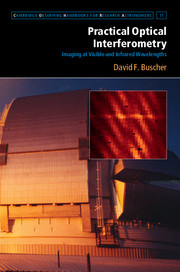Book contents
- Frontmatter
- Contents
- Principal symbols, functions and operators
- List of abbreviations
- Foreword
- Preface
- 1 Making fringes
- 2 Basic imaging
- 3 Atmospheric seeing and its amelioration
- 4 Interferometers in practice
- 5 Measurement noise
- 6 Interferometric observation of faint objects
- 7 Observation planning
- 8 Data reduction
- 9 Model fitting and image reconstruction
- Appendix A Fourier transforms
- Appendix B Supplementary online material
- References
- Index
3 - Atmospheric seeing and its amelioration
Published online by Cambridge University Press: 05 August 2015
- Frontmatter
- Contents
- Principal symbols, functions and operators
- List of abbreviations
- Foreword
- Preface
- 1 Making fringes
- 2 Basic imaging
- 3 Atmospheric seeing and its amelioration
- 4 Interferometers in practice
- 5 Measurement noise
- 6 Interferometric observation of faint objects
- 7 Observation planning
- 8 Data reduction
- 9 Model fitting and image reconstruction
- Appendix A Fourier transforms
- Appendix B Supplementary online material
- References
- Index
Summary
The interferometer described in Chapter 1 is an idealised one, where all the optical delays are known and stable. In such an interferometer the phase of the interference fringes measured for a point-like object at a chosen position on the sky (the phase centre) will be zero, and the fringe phase is a good ‘observable’. For a number of practical reasons, no existing optical interferometer even approaches this ideal.
First of all, the mechanical tolerances required to know the optical path difference (OPD) internal to the interferometer are formidable. If the position of a single mirror in the optical train is in error by a fraction of a millimetre then the phase of the fringes will be hundreds of radians from the value measured by an ideal interferometer.
While these mechanical errors could in principle be overcome through increasing the precision with which the interferometer is built, there are even more serious phase errors that are introduced external to the interferometer which no amount of increased construction accuracy will overcome. These errors are induced by the passage of starlight through the Earth's atmosphere on its way to the interferometer. The atmosphere introduces phase errors, which are large (many radians) and rapidly varying (on timescales of milliseconds), and so these errors present a fundamental limitation to interferometry from the ground.
The optical effects which cause these rapidly changing phase perturbations are known in astronomy as seeing. Seeing can be observed in single telescopes as the ‘boiling’ of stellar images, which looks similar to the ‘shimmering’ of images that can be seen on a hot day.
The effects of seeing on interferometers are of a different character to those on a single telescope: whereas on a single telescope the seeing affects the angular resolution which can be obtained, in an interferometer the resolution can be relatively little affected by the presence of seeing but the sensitivity can be dramatically altered.
- Type
- Chapter
- Information
- Practical Optical InterferometryImaging at Visible and Infrared Wavelengths, pp. 53 - 90Publisher: Cambridge University PressPrint publication year: 2015



